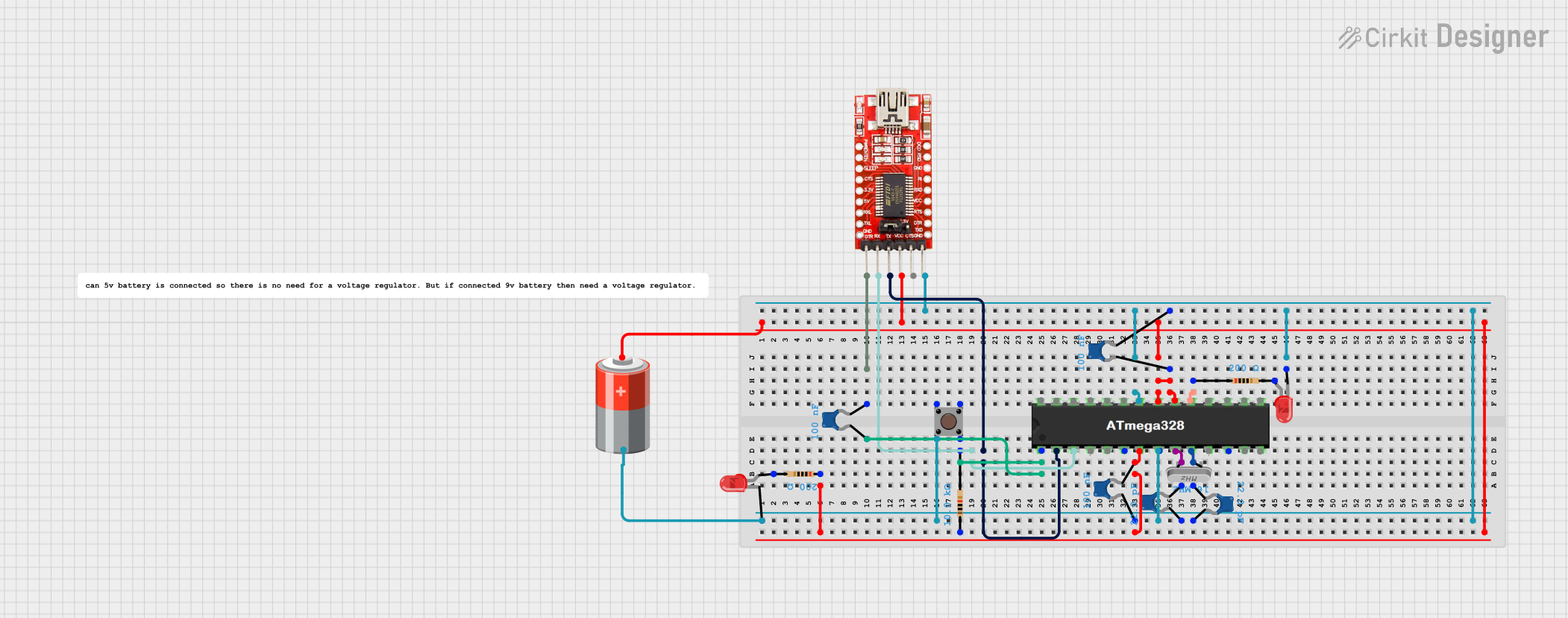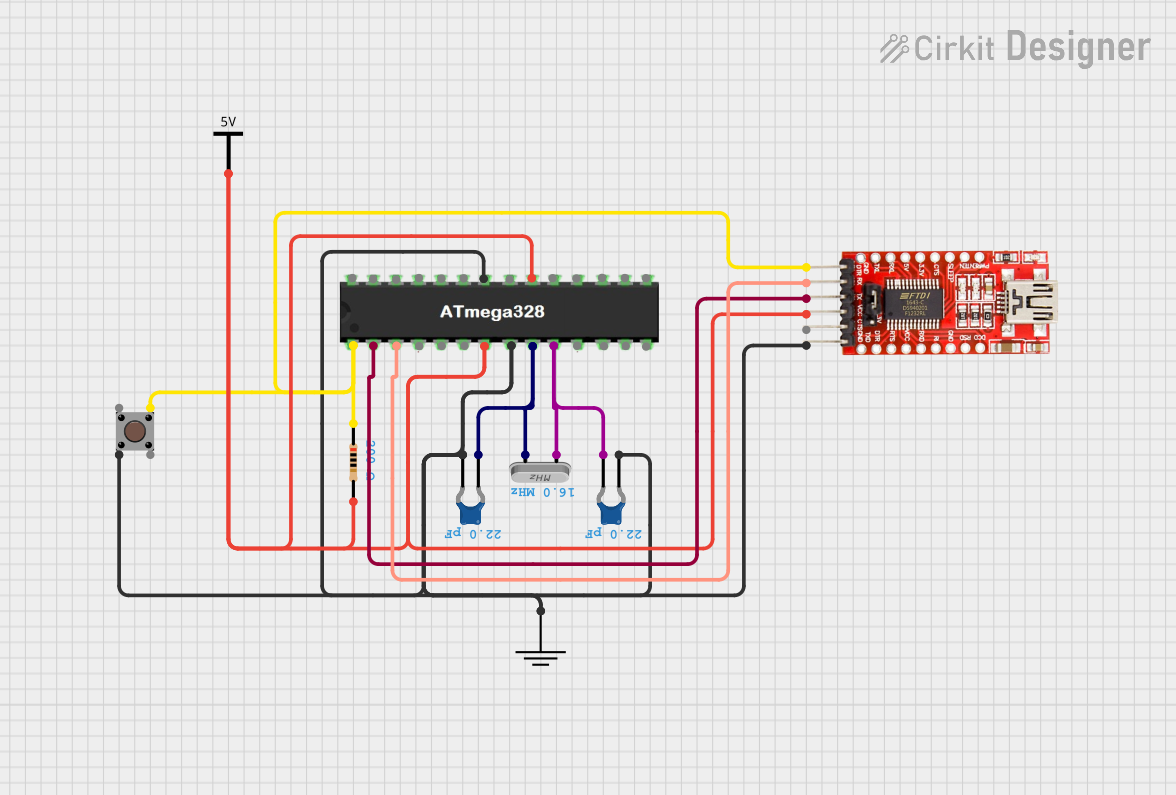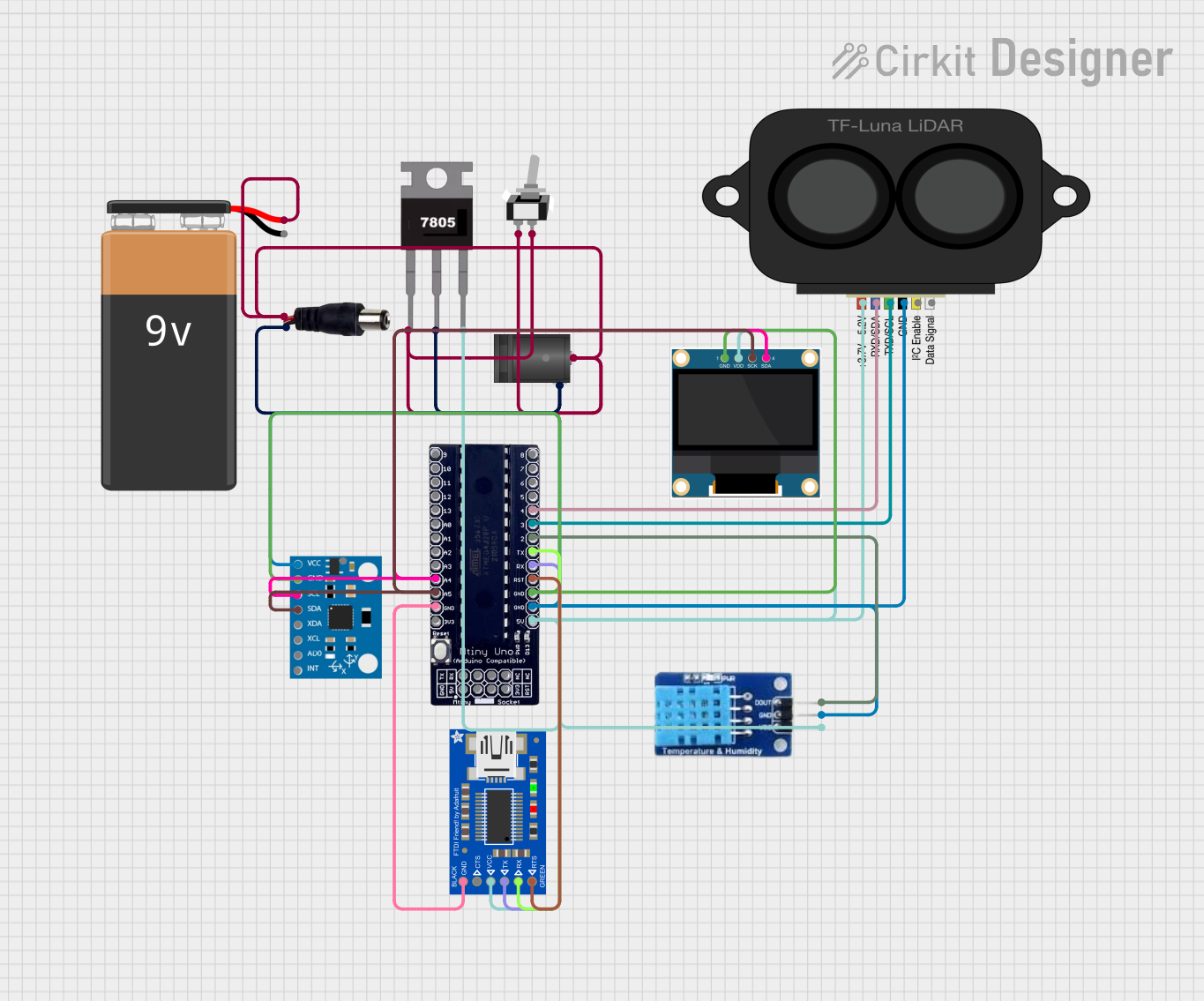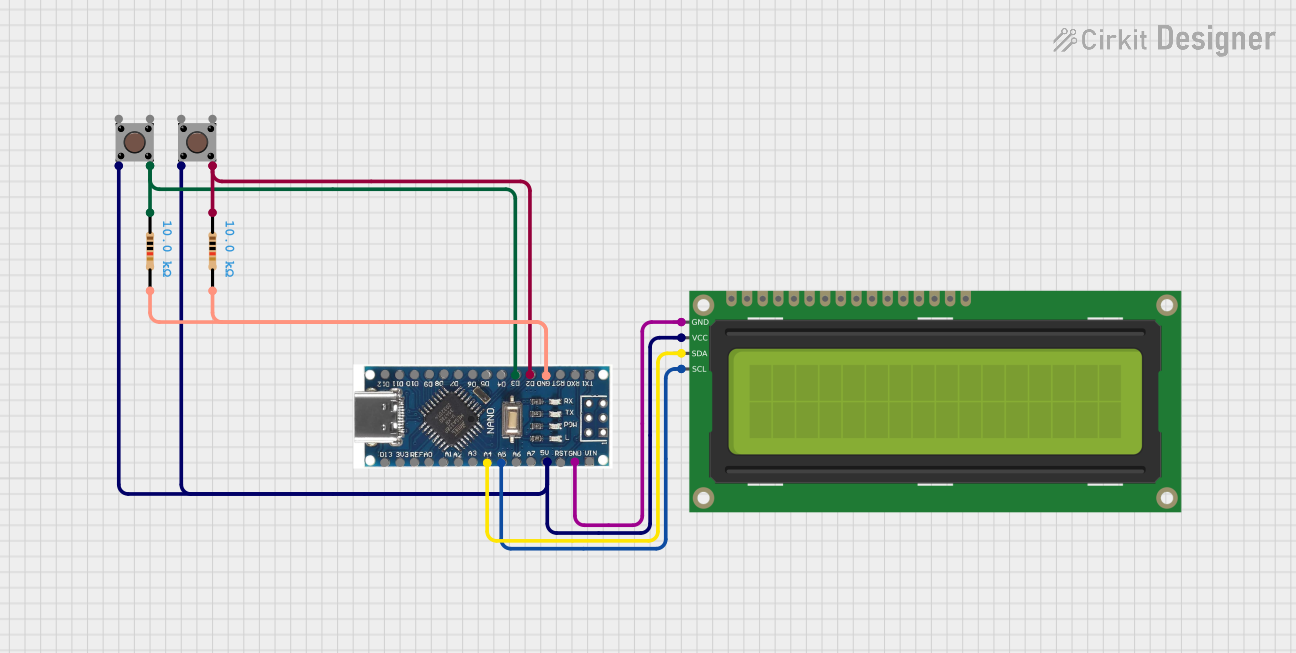
How to Use ATMEGA328P: Examples, Pinouts, and Specs

 Design with ATMEGA328P in Cirkit Designer
Design with ATMEGA328P in Cirkit DesignerIntroduction
The ATMEGA328P is a low-power 8-bit microcontroller developed by ATMEGA, based on the AVR architecture. It is widely used in embedded systems due to its versatility, low power consumption, and robust feature set. With 32 KB of flash memory, 2 KB of SRAM, and 1 KB of EEPROM, the ATMEGA328P is capable of handling a variety of tasks, from simple control systems to more complex applications.
Explore Projects Built with ATMEGA328P

 Open Project in Cirkit Designer
Open Project in Cirkit Designer
 Open Project in Cirkit Designer
Open Project in Cirkit Designer
 Open Project in Cirkit Designer
Open Project in Cirkit Designer
 Open Project in Cirkit Designer
Open Project in Cirkit DesignerExplore Projects Built with ATMEGA328P

 Open Project in Cirkit Designer
Open Project in Cirkit Designer
 Open Project in Cirkit Designer
Open Project in Cirkit Designer
 Open Project in Cirkit Designer
Open Project in Cirkit Designer
 Open Project in Cirkit Designer
Open Project in Cirkit DesignerCommon Applications and Use Cases
- Arduino Development Boards: The ATMEGA328P is the core microcontroller used in popular Arduino boards like the Arduino UNO.
- IoT Devices: Ideal for low-power Internet of Things (IoT) applications.
- Home Automation: Used in smart home devices such as thermostats and lighting systems.
- Robotics: Suitable for motor control, sensor interfacing, and communication in robotic systems.
- Industrial Automation: Used in control systems, data logging, and monitoring applications.
Technical Specifications
Key Technical Details
| Parameter | Value |
|---|---|
| Architecture | 8-bit AVR |
| Operating Voltage | 1.8V - 5.5V |
| Maximum Clock Speed | 20 MHz |
| Flash Memory | 32 KB |
| SRAM | 2 KB |
| EEPROM | 1 KB |
| Digital I/O Pins | 23 |
| PWM Channels | 6 |
| ADC Channels | 6 (10-bit resolution) |
| Communication Interfaces | UART, SPI, I2C |
| Timers | 3 (2 x 8-bit, 1 x 16-bit) |
| Power Consumption | 0.2 mA (Active Mode at 1 MHz) |
Pin Configuration and Descriptions
The ATMEGA328P is available in a 28-pin DIP (Dual Inline Package) and other package types. Below is the pin configuration for the 28-pin DIP package:
| Pin Number | Pin Name | Description |
|---|---|---|
| 1 | PC6/RESET | Reset Pin (Active Low) |
| 2 | PD0/RXD | Digital Pin 0 / UART Receive (RX) |
| 3 | PD1/TXD | Digital Pin 1 / UART Transmit (TX) |
| 4 | PD2 | Digital Pin 2 / External Interrupt 0 (INT0) |
| 5 | PD3 | Digital Pin 3 / PWM Output / External Interrupt |
| 6 | PD4 | Digital Pin 4 |
| 7 | VCC | Power Supply (2.7V - 5.5V) |
| 8 | GND | Ground |
| 9 | PB6/XTAL1 | Crystal Oscillator Input |
| 10 | PB7/XTAL2 | Crystal Oscillator Output |
| 11 | PD5 | Digital Pin 5 / PWM Output |
| 12 | PD6 | Digital Pin 6 / PWM Output |
| 13 | PD7 | Digital Pin 7 |
| 14 | PB0 | Digital Pin 8 |
| 15 | PB1 | Digital Pin 9 / PWM Output |
| 16 | PB2 | Digital Pin 10 / PWM Output |
| 17 | PB3 | Digital Pin 11 / PWM Output |
| 18 | PB4 | Digital Pin 12 |
| 19 | PB5 | Digital Pin 13 / SPI Clock (SCK) |
| 20 | AVCC | Analog Power Supply |
| 21 | AREF | Analog Reference Voltage |
| 22 | GND | Ground |
| 23 | PC0/ADC0 | Analog Input Channel 0 |
| 24 | PC1/ADC1 | Analog Input Channel 1 |
| 25 | PC2/ADC2 | Analog Input Channel 2 |
| 26 | PC3/ADC3 | Analog Input Channel 3 |
| 27 | PC4/ADC4 | Analog Input Channel 4 / I2C SDA |
| 28 | PC5/ADC5 | Analog Input Channel 5 / I2C SCL |
Usage Instructions
How to Use the ATMEGA328P in a Circuit
- Power Supply: Connect the VCC pin to a regulated power source (2.7V to 5.5V) and the GND pin to ground.
- Clock Source: Use an external crystal oscillator (e.g., 16 MHz) connected to the XTAL1 and XTAL2 pins, along with appropriate capacitors.
- Reset Circuit: Connect a 10 kΩ pull-up resistor to the RESET pin to ensure proper operation.
- Programming: Use an ISP (In-System Programmer) or an Arduino as an ISP to upload code to the microcontroller.
- I/O Connections: Connect sensors, actuators, or other peripherals to the digital and analog pins as needed.
Important Considerations and Best Practices
- Decoupling Capacitors: Place 0.1 µF decoupling capacitors close to the VCC and AVCC pins to reduce noise.
- Analog Reference: If using the ADC, connect the AREF pin to a stable reference voltage or leave it unconnected for the default reference.
- Unused Pins: Configure unused pins as inputs with pull-up resistors or as outputs to avoid floating states.
- Power Consumption: Use sleep modes to reduce power consumption in battery-powered applications.
Example Code for Arduino UNO
The ATMEGA328P is the microcontroller used in the Arduino UNO. Below is an example code to blink an LED connected to digital pin 13:
// Blink an LED connected to digital pin 13
// This code toggles the LED on and off every second.
void setup() {
pinMode(13, OUTPUT); // Set pin 13 as an output
}
void loop() {
digitalWrite(13, HIGH); // Turn the LED on
delay(1000); // Wait for 1 second
digitalWrite(13, LOW); // Turn the LED off
delay(1000); // Wait for 1 second
}
Troubleshooting and FAQs
Common Issues and Solutions
Microcontroller Not Responding:
- Cause: Incorrect power supply or missing decoupling capacitors.
- Solution: Verify the power supply voltage and ensure proper decoupling capacitors are in place.
Program Upload Fails:
- Cause: Incorrect ISP connections or wrong programmer settings.
- Solution: Double-check the ISP connections and ensure the correct programmer is selected in the IDE.
Analog Readings Are Inaccurate:
- Cause: Unstable reference voltage or noise on the analog pins.
- Solution: Use a stable reference voltage on the AREF pin and add filtering capacitors to the analog inputs.
High Power Consumption:
- Cause: Microcontroller running at full speed unnecessarily.
- Solution: Use sleep modes and reduce the clock speed if possible.
FAQs
Q: Can the ATMEGA328P run without an external crystal oscillator?
A: Yes, it has an internal 8 MHz oscillator, but an external crystal provides better accuracy.Q: How do I protect the microcontroller from voltage spikes?
A: Use TVS diodes or zener diodes on the power supply lines and add decoupling capacitors.Q: Can I reprogram the ATMEGA328P multiple times?
A: Yes, it supports up to 10,000 write/erase cycles for the flash memory.Q: What is the maximum current the I/O pins can source or sink?
A: Each I/O pin can source or sink up to 40 mA, but it is recommended to limit it to 20 mA for reliability.